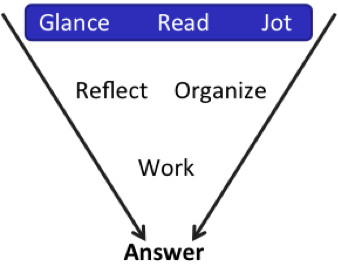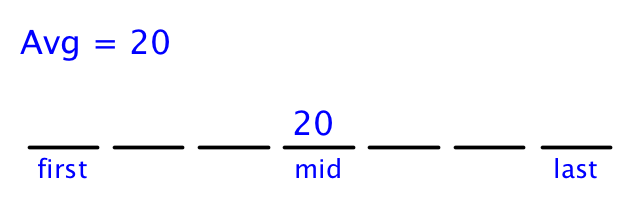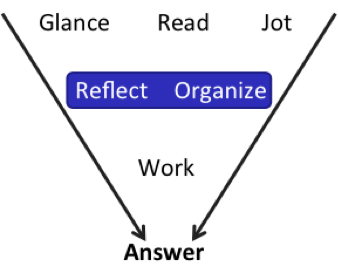-
Target Test Prep 20% Off Flash Sale is on! Code: FLASH20
Redeem
Tackling Max/Min Statistics on the GMAT - Part 2
 Last time, we discussed two GMATPrep problems that simultaneously tested statistics and the concept of maximizing or minimizing a value. The GMAT could ask you to maximize or minimize just about anything, so the latter skill crosses many topics. Learn how to handle the nuances on these statistics problems and youll learn how to handle any max/min problem they might throw at you.
Last time, we discussed two GMATPrep problems that simultaneously tested statistics and the concept of maximizing or minimizing a value. The GMAT could ask you to maximize or minimize just about anything, so the latter skill crosses many topics. Learn how to handle the nuances on these statistics problems and youll learn how to handle any max/min problem they might throw at you.
Feel comfortable with the two problems from the first part of this article? Then lets kick it up a notch! The problem below was written by us (Manhattan Prep) and its complicatedpossibly harder than anything youll see on the real GMAT. This problem, then, is for those who are looking for a really high quant scoreor who subscribe to the philosophy that mastery includes trying stuff thats harder than what you might see on the real test, so that youre ready for anything.
Ready? Here you go:
Both the average (arithmetic mean) and the median of a set of 7 numbers equal 20. If the smallest number in the set is 5 less than half the largest number, what is the largest possible number in the set?(A) 40
(B) 38
(C) 33
(D) 32
(E) 30
Out of the letters A through E, which one is your favorite?
You may be thinking, "Huh? What a weird question. I dont have a favorite."
I dont have one in the real world either, but I do for the GMAT, and you should, too. When you get stuck, youre going to need to be able to let go, guess, and move on. If you havent been able to narrow down the answers at all, then youll have to make a random guessin which case, you want to have your favorite letter ready to go.
If you have to think about what your favorite letter is, then you dont have one yet. Pick it right now.
Im serious. Im not going to continue until you pick your favorite letter. Got it?
From now on, when you realize that youre lost and you need to let go, pick your favorite letter immediately and move on. Dont even think about it.
(This assumes, of course, that your favorite letter is still in the mix. If you were able to narrow down the answers, and you crossed off your favorite letter, then obviously dont pick that one!)
Okay, lets solve this thing. What did you do first?
I glanced at the beginning of the text and saw that it said average (arithmetic mean). I then glanced down to the answers to see how precise I was going to have to be with calculations. The answers are very close together, so estimation isnt going to work. Im going to have to do real math.
Okay, time to read the problem and jot down the given info.
Because the problem gives the median, arrange the numbers in order from smallest to largest (this is a general requirement whenever calculating or displaying a median).
Hmm. That second sentence of the problem is going to take some work. Its a relationship between the first and last numberbut I dont know the actual value of either one.
Time to set a variable: lets call something x. My natural inclination would be to call the smallest number x, but Ive learned to ask myself one important question before arbitrarily assigning that variable: what am I trying to find?
In this case, they asked for the largest possible number, so its better to call the last number x. That way, Ill be solving for the thing that they want; Im less likely to make a mistake and accidentally solve for x = the smallest number.
If the largest number is x, then the smallest is (1/2)x 5:
What next? If the average is 20 and there are 7 numbers, then the sum must be (Average)(number of terms) = (20)(7) = 140.
Pause for a moment and look at everything youve got. What's the best plan from here?
They want to maximize the largest number, that x. Only one number is set, the middle one (20). All 7 numbers have to add up to 140.
So what needs to happen in order to make x as large as possible?
Since the sum is fixed, the first 6 numbers need to be minimized in order to get the last number to be as large as possible. This step is the key to all max/min problems: figure out what you can influence and either maximize or minimize (as needed) to get to the desired outcome.
Look back at your notes to remind yourself of the restrictions. The fifth and sixth numbers cannot be less than the median of 20. They could equal the median, though, so set these values to 20:
That leaves a sum of 140 20(3) = 80 for the remaining 4 numbers.
Now, what about the second and third values? Again, they cant be smaller than the first one, but they could equal it. Set all three equal to (1/2)x 5.
Check it out: you now have a way to express each of the remaining four numbers in terms of that single variable x. Time to set up an equation and solve!
[pmath]3({1/2}x-5)+x=80[/pmath]
[pmath]{3/2}x-15+x=80[/pmath]
[pmath]{5/2}x=95[/pmath]
[pmath]x=95(2/5)[/pmath]
[pmath]x=38[/pmath]
The largest possible number in the set is 38.
The correct answer is (B).
I originally intended this to be a 2-part series, but I just found another GMATPrep max/min problem, so join me next time for another look at this topic!
Key Takeaways for Max/Min Problems:
(1) Figure out what variables are in play: what can you manipulate in the problem? Some of those variables will need to be maximized and some minimized in order to get to the desired answer. Figure out which is which at each step along the way.
(2) Youll need to know your math concepts in order to figure out clever ways to maximize and minimize. In the case of a set of numbers for which the median is specified, that set has to be laid out from smallest to largestthats a requirement for median problems. Once thats done, you now have restrictions for the different numbers: each one has to be greater than or equal to the number just before it (to the left). It also has to be smaller than or equal to the number after (the one to the right). These restrictions are key in helping you determine how to maximize or minimize one particular number in the set.
(3) Did you make a mistakemaximize when you should have minimized or vice versa? Go through the logic again, step by step, to figure out where you were led astray and why you should have done the opposite of what you did. (This is a good process in general whenever you make a mistake: figure out why you made the mistake you made, as well as how to do the work correctly next time.)
* Copyright Manhattan Prep. Question cannot be distributed or posted elsewhere without permission.
Recent Articles
Archive
- April 2024
- March 2024
- February 2024
- January 2024
- December 2023
- November 2023
- October 2023
- September 2023
- July 2023
- June 2023
- May 2023
- April 2023
- March 2023
- February 2023
- January 2023
- December 2022
- November 2022
- October 2022
- September 2022
- August 2022
- July 2022
- June 2022
- May 2022
- April 2022
- March 2022
- February 2022
- January 2022
- December 2021
- November 2021
- October 2021
- September 2021
- August 2021
- July 2021
- June 2021
- May 2021
- April 2021
- March 2021
- February 2021
- January 2021
- December 2020
- November 2020
- October 2020
- September 2020
- August 2020
- July 2020
- June 2020
- May 2020
- April 2020
- March 2020
- February 2020
- January 2020
- December 2019
- November 2019
- October 2019
- September 2019
- August 2019
- July 2019
- June 2019
- May 2019
- April 2019
- March 2019
- February 2019
- January 2019
- December 2018
- November 2018
- October 2018
- September 2018
- August 2018
- July 2018
- June 2018
- May 2018
- April 2018
- March 2018
- February 2018
- January 2018
- December 2017
- November 2017
- October 2017
- September 2017
- August 2017
- July 2017
- June 2017
- May 2017
- April 2017
- March 2017
- February 2017
- January 2017
- December 2016
- November 2016
- October 2016
- September 2016
- August 2016
- July 2016
- June 2016
- May 2016
- April 2016
- March 2016
- February 2016
- January 2016
- December 2015
- November 2015
- October 2015
- September 2015
- August 2015
- July 2015
- June 2015
- May 2015
- April 2015
- March 2015
- February 2015
- January 2015
- December 2014
- November 2014
- October 2014
- September 2014
- August 2014
- July 2014
- June 2014
- May 2014
- April 2014
- March 2014
- February 2014
- January 2014
- December 2013
- November 2013
- October 2013
- September 2013
- August 2013
- July 2013
- June 2013
- May 2013
- April 2013
- March 2013
- February 2013
- January 2013
- December 2012
- November 2012
- October 2012
- September 2012
- August 2012
- July 2012
- June 2012
- May 2012
- April 2012
- March 2012
- February 2012
- January 2012
- December 2011
- November 2011
- October 2011
- September 2011
- August 2011
- July 2011
- June 2011
- May 2011
- April 2011
- March 2011
- February 2011
- January 2011
- December 2010
- November 2010
- October 2010
- September 2010
- August 2010
- July 2010
- June 2010
- May 2010
- April 2010
- March 2010
- February 2010
- January 2010
- December 2009
- November 2009
- October 2009
- September 2009
- August 2009




